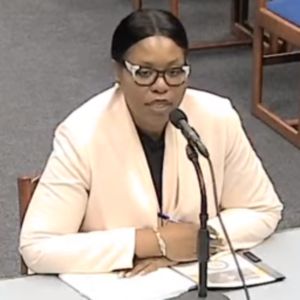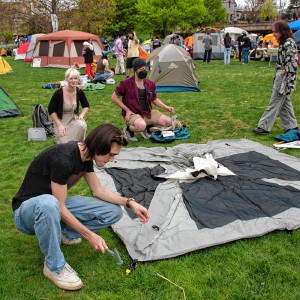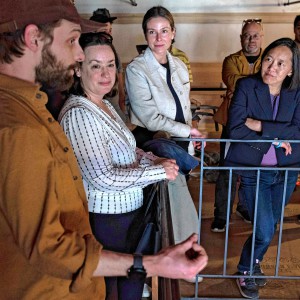Rintala murder jury views extensive blood evidence in basement
| Published: 09-21-2023 7:51 PM |
NORTHAMPTON — Police and crime scene analysts who responded to 18 Barton St. in Granby in the wake of Annamarie Cochrane Rintala’s 2010 slaying shed light in court Thursday on the extensive blood evidence found at the scene.
A State Police sergeant with experience in cases of breaking and entering testified also on the damage found on the home’s side door jamb.
Cara Rintala, 57, is charged with killing Cochrane Rintala, her wife, by strangulation and blunt force. This is the fourth time she has been tried in Hampshire Superior Court.
Prosecutors on Thursday called forensic scientists Caroline Tatro and Jennifer Preisig of the Massachusetts State Police Crime Laboratory to testify on the extensive bloodstain evidence found on the home’s basement floor, where Cochrane Rintala’s body was found, the basement stairway walls and steps, and a shelving unit.
Tatro explained that she used the orthotolidine (OT) test on the red-brown stains at the scene as a preliminary screening test. If positive, the samples would undergo further testing at the laboratory.
With the use of crime scene photos, Tatro pointed out all the samples of suspected blood in and leading to the basement. She said all tested positive for blood at the scene, and indicative of human blood under more rigorous lab testing. The samples were then sent for DNA testing.
Trooper Erin Karella of the State Police Crime Scene Services testified further that bloodstains on the basement floor extended under the lid of a 5-gallon paint bucket where it lay on the floor. Prosecutors argue that Rintala dumped the paint herself just before she called police.
Under further questioning by Deputy Northwestern District Attorney Jennifer Suhl, Tatro testified that a black fleece and pair of jeans taken from the scene tested positive for blood, as did scrapings taken from under Cochrane Rintala’s fingernails.
Article continues after...
Yesterday's Most Read Articles
 A Waterfront revival: Two years after buying closed tavern, Holyoke couple set to open new event venue
A Waterfront revival: Two years after buying closed tavern, Holyoke couple set to open new event venue
 Services being held Thursday for Greenfield homicide victim
Services being held Thursday for Greenfield homicide victim
 Island superintendent picked to lead Amherst-Pelham region schools
Island superintendent picked to lead Amherst-Pelham region schools
 Area property deed transfers, May 2
Area property deed transfers, May 2
 Granby Bow and Gun Club says stray bullets that hit homes in Belchertown did not come from its range
Granby Bow and Gun Club says stray bullets that hit homes in Belchertown did not come from its range
 3-unit, 10-bed house in backyard called too much for Amherst historic district
3-unit, 10-bed house in backyard called too much for Amherst historic district
There was no evidence that she had been sexually assaulted, Tatro said.
Preisig, Tatro’s supervisor at the time, offered analysis of bloodstain patterns. Marks on the basement stairway wall she characterized as swipe stains, a type of transfer stain. Transfer stains are made when a bloodied person or object makes contact with a surface, while swipe stains involve movement.
On the basement floor were spatter stains made by blood in flight, Preisig said, and smear stains, as if the stain had been wiped. Multiple transfer stains were found on the shelving.
A post-style earring with no backing was found on a small rug at the foot of the basement stairs. The post and the stone both tested positive for blood, Preisig said.
The slightly bent backing of the earring, found out in the breezeway near the side door, had no blood on it, she said. Another earring was found inside the body bag used to transport Cochrane Rintala to the medical examiner’s office.
Other evidence was collected from outside the house and around the doorway. State Police Sgt. Todd Girouard testified that investigators found a shovel leaning against the outside garage wall, with a white residue on the tip. The tip of the shovel was bent, and at the side door there were crescent-shaped tool marks on the inside of the door jamb.
Tatro and Karella previously testified that there were wood chips with paint on them on the doormat and inside the door frame.
There was damage to the weather stripping on the jamb, but none to the door itself or the glass window in the door, Girouard said.
There also was no damage to the strike plate or face plate holding the latch when the door is closed. Under questioning from First Assistant District Attorney Steve Gagne, Girouard said he would expect the face plate to be dislodged or pulled out completely if the door had been forced.
Prosecutors have alleged that Rintala damaged the doorway herself after killing her wife to give the appearance of a break-in.
Girouard detailed the use of leuco crystal violet in detecting bloodstains that can’t be seen. He also testified that he brought the rags that retired state trooper Christopher Ray had collected from the garbage at the Holyoke McDonald’s and laid them out on butcher paper on the living room carpet to dry.
Under questioning by defense attorney Rosemary Scapicchio, Girouard acknowledged that this was not proper crime scene procedure.
He also said he had taken a class in retrieving fingerprints from a body, but he said the Crime Scene Lab did not have the chemicals necessary to do so.
“It’s a process we’ve never used,” he said.
Scapicchio also pressed Tatro on the hairs found on Cochrane Rintala’s body, and whether some were cat hairs.
Tatro acknowledged she had listed “animal hair app. cat” in her notes, but only wrote “animal hair” in her report. The Rintalas did not have a cat.
At the close of Thursday’s testimony, Judge Francis Flannery dismissed the jury until Monday. Gagne said there was a “decent chance” the commonwealth would rest its case then.

 Pro-Palestinian encampment disperses at UMass, but protests continue
Pro-Palestinian encampment disperses at UMass, but protests continue Amherst council confirms Gabriel Ting as police chief
Amherst council confirms Gabriel Ting as police chief Music key to Northampton’s downtown revival: State’s top economic development leader tours city
Music key to Northampton’s downtown revival: State’s top economic development leader tours city 
